In the last decade of the 16th century there was a press working in the Franciscan Convent at Vimpác in West-Hungary. Beside the printing shop in Nagyszombat (Trnava, SK) this was the only press producing books for readers of Catholic confession.
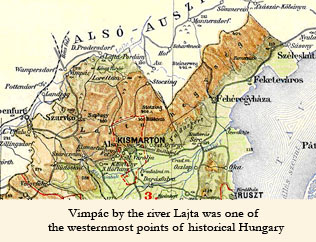 The Franciscan friars were invited to Vimpác by Ruprecht von Stotzingen, and in 1593 their church was also consecrated. The noble family also donated a library to the Franciscans and the cloister at Stotzing where Servitans were settled was also Stotzingen's foundation. The estate was soon purchased by the Hungarian magnate Ferenc Nádasdy who moved the Servitans to the nearby Lorettom - being also a printing place a century later.
The Franciscan friars were invited to Vimpác by Ruprecht von Stotzingen, and in 1593 their church was also consecrated. The noble family also donated a library to the Franciscans and the cloister at Stotzing where Servitans were settled was also Stotzingen's foundation. The estate was soon purchased by the Hungarian magnate Ferenc Nádasdy who moved the Servitans to the nearby Lorettom - being also a printing place a century later.
The convent at Vimpác ceased in the first decades of the 17th century when it was ruined by either Bocskai's or Bethlen's military campaign. According to other sources it was only in 1627 when the Franciscan friars definitely left Vimpác.
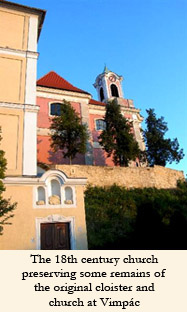 Until quite recently, in the 1960s when some printings with the imprint Vimpác were discovered, no one new about the existence of the Vimpác press - its activity was entirely forgotten.
Until quite recently, in the 1960s when some printings with the imprint Vimpác were discovered, no one new about the existence of the Vimpác press - its activity was entirely forgotten.
Of its five products three are from 1593, the two others from 1595 and 1599, respectively; their language is either Latin or German. As to the genre and subject, all the five works are closely connected with the Franciscan convent. The equipment of the printing shop was probably acquired by the founder Stotzingen in Vienna, and the master of the good quality woodcuts might have also been from Vienna. The printing press of Vimpác donated by the patron was very well equipped and could suitably meet local demands.
The printer's person remains hidden, according to the practice of Franciscan presses: it is never mentioned in the imprint giving otherwise the full name of the locality: "Wimpassing an der Leytta in Ungarn" i. e. at Vimpác by the river Lajta in Hungary.
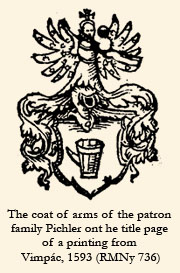 The set of printing types consisted of eight types mostly fraktur in accordance with the several German prayer books leaving the press. There were seven ornaments serving for the decoration of prayer-books, among the two woodcut coats of arms of the patron families Pichler and Stotzingen. The masterly craft of the unknown printer is proved by the recurring employment of two-colour, red and black printing.
The set of printing types consisted of eight types mostly fraktur in accordance with the several German prayer books leaving the press. There were seven ornaments serving for the decoration of prayer-books, among the two woodcut coats of arms of the patron families Pichler and Stotzingen. The masterly craft of the unknown printer is proved by the recurring employment of two-colour, red and black printing.
A good quality full-page woodcut is illustrating the book about the vision preceding the foundation of the convent: a crucifix representing the heavenly apparition taking place in the vicinity of Klagenfurt on the 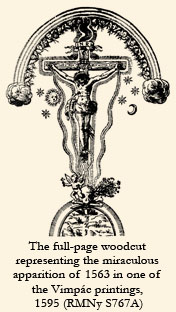 17th June 1563. The preface tells how Leonhard Pichler von Weitteneck made a vow in 1562 to offer a part of his income to the glory of God and to the benefit of the poor. Next year on the very day of the anniveersary Jesus on the cross appeared to him and the phenomenon was presently drawn, later painted by him. The 200x145 mm woodcut truly reflecting the vision is part of the printing from 1595.
17th June 1563. The preface tells how Leonhard Pichler von Weitteneck made a vow in 1562 to offer a part of his income to the glory of God and to the benefit of the poor. Next year on the very day of the anniveersary Jesus on the cross appeared to him and the phenomenon was presently drawn, later painted by him. The 200x145 mm woodcut truly reflecting the vision is part of the printing from 1595.
As the Franciscan convent was existing for more than two decades, it cannot be excluded that the press survived the turn of the 16/17th centuries and in this case there may crop up printings from the beginning of the 17th century.


LITERATURE
SEMMELWEISS, Karl: Ismeretlen 16. századi nyomda a mai Burgenland területén (Vimpác) In: Magyar könyvszemle 1966. 338-344.
BORSA Gedeon: A vimpáci ferences nyomda és annak újabb terméke 1595-ből. In: Magyar könyvszemle 1980. 178-185.


- Printing types and Printer's flowers - Book ornaments - back to the top -
PRINTING TYPES AND PRINTER'S FLOWERS

- Printing types and Printer's flowers - Book ornaments - back to the top -
BOOK ORNAMENTS
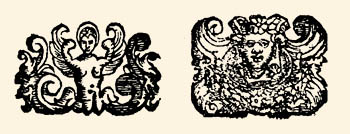 |
| two tail-pieces: one representing an angel, the other a female head with a wreath of flowers in her neck
|


- Printing types and Printer's flowers - Book ornaments - back to the top -
